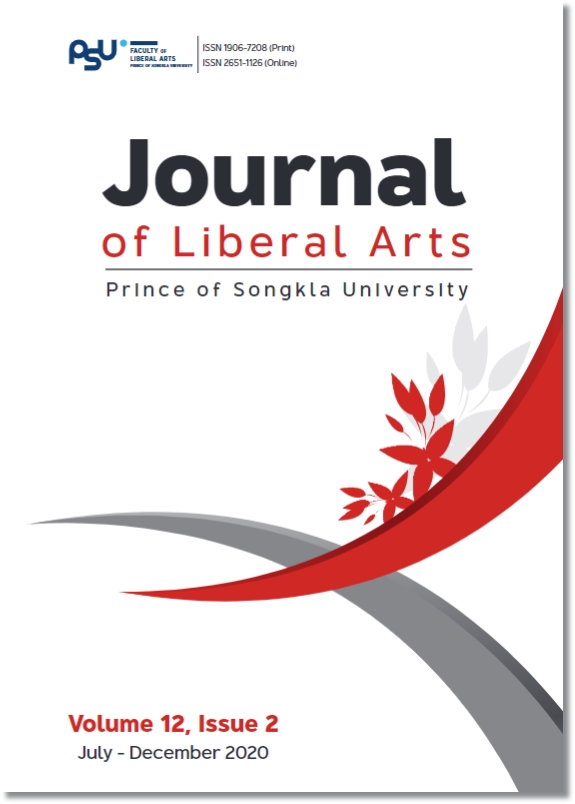A Spatial Database Creation of Land Use for Planning to Prevent Damage from Drought and Flooded Areas with Geographic Information System
Keywords:
landuse, spatial database, drought, floodAbstract
This study aims 1) to create a spatial database of land use in order to analyze the agricultural potentials in Nakhon Ratchasima province, and 2) to apply geographic information system for planning to prevent damages from drought and flooded areas in Nakhon Ratchasima province.
It is a collection of secondary information from the KORAT_GIS research document database, field data collection, capture of geographic coordinates, translation of satellite images to classify land use by the supervised classification technique together with the Potential Surface Analysis (PSA) spatial analysis methods. Data is superimposed and areas at risk of flooding and drought are assessed by scoring and ranking the risk in each area. It was found that 1) accurate and appropriate spatial databases were obtained as follows: (1) land use database, (2) soil series database, (3) community product database or agricultural OTOP, (4) agricultural local wisdom database, and (5) database of potential analysis/problem of the area; and 2) in terms of drought risk areas, it was found that there is no risk of drought for an area of 20,818.75 rai, low risk of drought for an area of 1,564,718.75 rai, moderate drought risk for an area of 9,516,237.50 rai, and high risk for an area of 1,738,787.50 rai. Most of the areas, constituting three quarlters, are at a moderate risk of drought. In terms of flood risk areas, it was found that an area of 9,587,075.63 rai, constituting three quarters, found in the lower part of the province with relatively high topography and mountains are prone to flooding at a low level. There is a moderate flood risk for an area of 3,415,358.13 rai found in the middle part of the province as well as spreading across the province, and a high risk of flooding for an area of 506.88 rai found in the upper area of the province.
References
Bernhardsen, T. (1999). Geographic information system: An introduction. 2nd ed. John Wiley.
Chanlikhit, D. (1998). Principles of database design in geographic databases. Department of Geography, Faculty of Arts, Chulalongkorn University. [in Thai]
Department of Disaster Prevention and Mitigation, Ministry of Interior, Thailand. (2015). Annual report 2015. http://www.disaster.go.th/upload/download/file_attach/5769077bcd659.pdf [in Thai]
Department of Disaster Prevention and Mitigation, Ministry of Interior Thailand. (2018). Establishment of an action plan for disaster prevention and mitigation of local administrative organizations B.E. 2561. https://
www.disaster.go.th/th/cdetail-14448-perimeter_fence-193-4/ [in Thai]
Doydee, P. & Vaesorn, S. (2015). Geography for creating a map of some economic crop areas in Nong Han Luang area, Sakon Nakhon province. Faculty of Natural Resources and Agro-Industry, Kasetsart University Chaloem Phrakiat Campus, Sakon Nakhon Province. [in Thai]
Environmental Systems Research Institute. (1996). Using avenue customization and application development for ArcView GIS. Redlands. ESRI. [in Thai]
Foipikul, W. and others. (2014). Spatial potential of Nakhon Ratchasima Province. Nakhon Ratchasima: Nakhon Ratchasima Rajabhat University. [in Thai]
Geo-Informatics and Space Technology Development Agency. (2014). Annual flood areas, the whole country. http://www.flood.gistda.ro.th/ [in Thai]
Hong, S. and others. (2004). Mapping Pre-European settlement vegetation using a hierarchical bayesian model and GIS. http://www.google.com/search? q=gis+and+settlement&hlth&lr=N [in Thai]
Limkomoluilas, T. (2014). Integrated geoinformatics models for land-use management in Lamtakong Watershed, Nakhon Ratchasima Province [Unpublished doctoral dissertation]. Kasetsart University. [in Thai]
Longley, P. A. and others. (2001). Geographic information systems and science. John Wiley. [in Thai]
Meejing, K. and others. (2019). Application of geographic information system for assessing flood risk areas and receiving areas: A case study of the southern area of Suphan Buri Province. Faculty of Technology and Environment, Prince of Songkla University, Phuket Campus. [in Thai]
Meteorological Department. (2016). Drought. https://itunes.apple.com/th/app/thai-weather/id734275345?l=th [in Thai]
Ministry of Science Technology and environment. (2007). Complete report on the drought risk area information system development project. Khon Kaen University Center. [in Thai]
Mongkolsawat, C. and others. (2006). Northeast spatial potential for development. Geospatial Center for Northeastern Development, Khon Kaen University. Khon Kaen Printing House. [in Thai]
Nakhon Ratchasima Rajabhat University. (2004). Study area. Nakhon Ratchasima Rajabhat University: Ratchasima. [in Thai]
Noijasin, L. (2015). Application of geographic information system to assess flood risk areas in Sa Kaeo Province. Faculty of Science and Social Sciences, Burapha University, Sa Kaeo Campus. [in Thai]
Office of the National Economic and Social Development Board. (2017). The national economic and social development plan No.12. https://www.nesdb.go.th/ewt_news.php?nid=6420&filename=develop_issue
[in Thai]
Pakdeewatthanakun, K. & Kruautsaha, J. (2001). Database design. Thai Charoen Publication. [in Thai]
Pandey, S. and others. (2012). Coping with drought in rice farming in Asia : Insights from a cross-country [master’s thesis]. Proquest Dissertations and Theses Database. (UMI No.1697466689). [in Thai]
Sawadee, C. (2011). Analysis of drought risk areas in the Mae Klang River Basin for sustainable land use. Kasetsart University, Bangkok. [in Thai]
Sernkandee, P. and others. (2014). Area analysis: Risk of flooding by using geographic information system in Khuan Khun Non District, Phatthalung Province. Songkhla: Geographic Information Science Program, Faculty of Science and Technology, Hat Yai University. [in Thai]
Sethakun, N. and others. (2008). The geographic information system of the Pak Phanang River Basin, as well as the deterrmination of the likely area of natural disasters in the Pak Phanang River Basin: A complete report. Walailak University, in collaboration with the Research Fund Office (TRF). Bangkok: Walailak University. [in Thai]
Thanaroon, S. & Amonsanguansin, J. (2008). Application of GIS in the determination of flood risk areas in Ang Thong Province [Unpublished master’s thesis]. National Institute of Development Administration. [in Thai]
Downloads
Published
How to Cite
Issue
Section
License
The authors retain the copyright to their article but the Journal of Liberal Arts, Prince of Songkla University reserves the exclusive rights to first publication.






